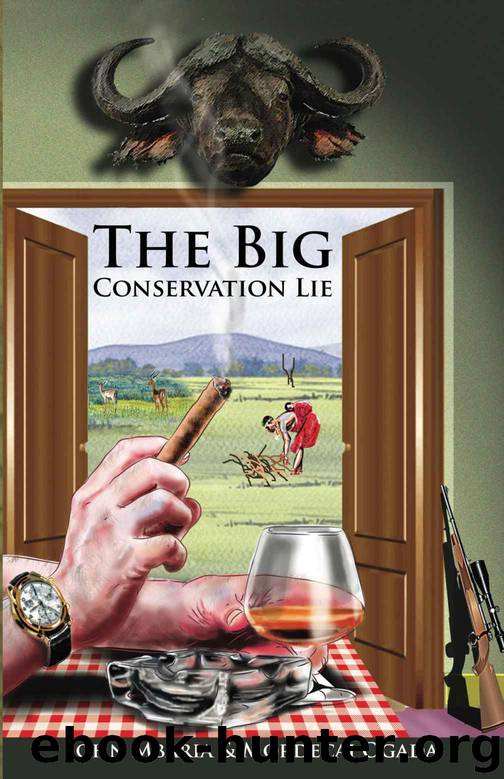The Big Conservation Lie by John Mbaria

Author:John Mbaria [Mbaria, John]
Language: eng
Format: epub
Publisher: Lens&Pens Publishing LLC
Published: 2017-03-14T23:00:00+00:00
4 ~ White Corruption in African Conservation
The need for Caucasian validation: In its promotional stickers, all the biodiversity, landscape, and intrinsic values of Kora National Park escape the KWS. Only the fact that one George Adamson lived there seems to matter.
(©Mordecai Ogada)
T he nature and content of current discourse on conservation rarely allows for the use of the words white, corruption, and conservation together in any context. Firstly, because conservation in Africa has built around itself the well-worn aura of altruism and absence of any material gain therefrom. When corruption occurs in this sector, it is never addressed as such and is covered up by a society desperate to hang on to the mythical romantic story of the selfless conservationist, like the late George Adamson for example. It therefore becomes white like white lies, which are often known to be untruths but are never overtly addressed or accepted as such. The misdirection, misallocation, and misuse of corporate resources to serve various personal interests has gone on in Africa for many generations, as it no doubt has in all human societies around the world. In Africa, this vice really came into its own with the establishment of countries, currencies, structured economies, and the realization of the value of her natural resources during the much-vaunted scramble for Africa’s resources during the nineteenth century.
The wave of independence that swept across Africa in the latter half of the twentieth century ushered in indigenous governments composed of local elites who had learned well at the feet of the colonial governments. They took avarice, selfishness, cruelty, discrimination, and general graft to unprecedented levels. Even as they did this, they thumped their own chests and were revered by ignorant local populations for their role in winning freedom for their people. In Kenya, these so-called freedom fighters stepped ably into the space left by the colonizers. But in Kenya, and many parts of Africa, the one place the colonizers never moved out of (and the natives never sought for themselves) was the biodiversity sector, encompassing the conservation, consumptive, and nonconsumptive use of this resource.
There is a cultural background to this attitude that is apparent when one closely examines most preindustrial tropical African societies. Most food and energy resources were hunted or gathered, with the only constraints being the difficulty in handling the resources with the implements available at the time. Resources were abundant, and their availability was essentially constant due to the absence of seasonality. Unlike temperate lands, tropical Africa doesn’t have significant variations in day length, temperatures, and natural resource availability throughout the year. In preindustrial temperate lands, natural resources had to be planned for, managed, conserved, gathered in bulk, stored, preserved and traded. This was essential in order for people to survive from the boom of summer against the deprivation brought about by the onset of winter. It was a matter of life and death, and only those who could do this survived and went on to colonize tropical lands. In tropical Africa, those who fished, hunted, and gathered edible plants did so throughout the year for generations.
Download
This site does not store any files on its server. We only index and link to content provided by other sites. Please contact the content providers to delete copyright contents if any and email us, we'll remove relevant links or contents immediately.
The Lonely City by Olivia Laing(4750)
Animal Frequency by Melissa Alvarez(4395)
All Creatures Great and Small by James Herriot(4232)
Walking by Henry David Thoreau(3893)
Exit West by Mohsin Hamid(3777)
Origin Story: A Big History of Everything by David Christian(3648)
COSMOS by Carl Sagan(3554)
How to Read Water: Clues and Patterns from Puddles to the Sea (Natural Navigation) by Tristan Gooley(3406)
Hedgerow by John Wright(3275)
The Inner Life of Animals by Peter Wohlleben(3259)
How to Read Nature by Tristan Gooley(3249)
How to Do Nothing by Jenny Odell(3232)
Project Animal Farm: An Accidental Journey into the Secret World of Farming and the Truth About Our Food by Sonia Faruqi(3177)
Origin Story by David Christian(3147)
Water by Ian Miller(3127)
A Forest Journey by John Perlin(3027)
The Plant Messiah by Carlos Magdalena(2883)
A Wilder Time by William E. Glassley(2818)
Forests: A Very Short Introduction by Jaboury Ghazoul(2790)
